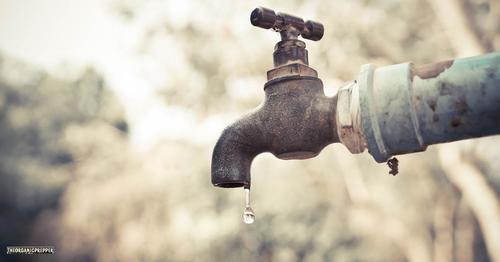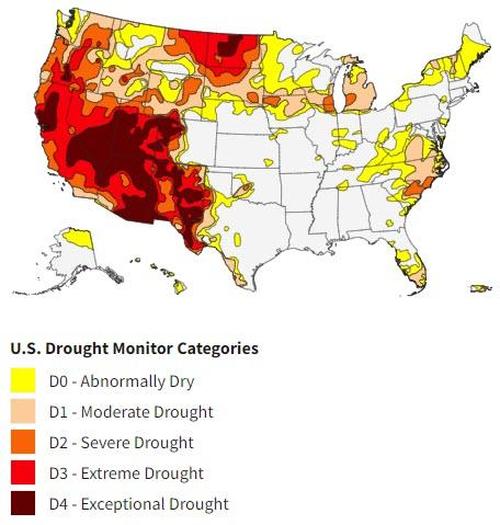California And Nevada Are Now 100% In Drought
Authored by Robert Wheeler via The Organic Prepper blog,
California and Nevada are 100% in drought.
Direct from Drought.gov:
After two water years of dry conditions, both California and Nevada are now 100% in drought. And with dire drought conditions, rapidly decreasing snowpack, and low reservoir levels, concern for wildfire season is growing.
This is a dry spell not seen since the Great Depression and the Dust Bowl days. Because of the drought, Americans very likely will experience a shocking food shortage very soon.
As explained in my previous article, drought is also affecting Arizona, and Colorado and the prairie states like Kansas, Nebraska, and the Dakotas. However, other states such as those in the Midwest and areas considered the nations’ “corn belt” also suffer from the drought.
Midwest states suffering the most
Here are the states in the Midwest currently experiencing drought conditions:
-
Iowa – Iowa has been in a state of drought for some time. About 8% of the state is considered “severe drought,” an area spanning about 12 counties in the northwestern part of the state. About 64% of Iowa currently suffers from “abnormally dry conditions, or worse.”
-
Illinois – Drought in Illinois, particularly the northeastern portion, has intensified to severe is now covering about 6% of the state. Abnormally dry conditions are present across the northern region and east side of the state. About 27% of the state is suffering from “abnormally dry conditions, or worse.”
-
Nebraska – One of the lucky ones, Nebraska received some much-needed rain. Unfortunately, that wasn’t enough to end the drought. Moderate drought is at 16%, while 45% of the state suffers from “abnormally dry conditions, or worse.”
-
Indiana – Probably the least dry state of the drought-stricken Midwest. Less than 1% of the state in drought conditions though about 21% reporting “abnormally dry conditions.”
-
Minnesota – The drought is getting worse in Minnesota. Two counties in the northwest of the state are in “severe drought” while “moderate drought” has spread to 21% of the state. Overall, about 55% of the state suffers from “abnormally dry conditions, or worse.”
-
Michigan – Michigan hasn’t been spared either. 78% of the state is experiencing “abnormally dry conditions,” 64% “moderate drought, and 6% “severe drought.”
Southeast U.S. is not as bad, but still not looking good
The Southeast United States is faring better. However:
-
Virginia, North Carolina, and South Carolina are experiencing drought conditions as well.
-
Texas, not mentioned as much: 52% experiencing “abnormally dry conditions,” 32% “moderate drought,” 20% “severe drought,” and 12% “extreme drought.” Nearly 6% of the state is experiencing “exceptional drought.”
-
Though typically a dry state, New Mexico is 100% experiencing “abnormally dry conditions,” 99% “moderate drought,” 96% “severe drought,” 77% “extreme drought,” and 47% “exceptional drought.”
Still don’t believe the U.S. is suffering a severe dry spell?
The issue went before the U.S. Congress. From the AZ Mirror:
A drought crisis unfolding across the West will require short-term relief and massive, long-term federal funding to help states weather the effects of climate change, state water managers and lawmakers said at a U.S. House hearing on Tuesday.
Nearly 90 percent of the West is now experiencing drought conditions, according to the federal U.S. Drought Monitor. The problem is particularly acute in the Southwest.
Many states suffer from the driest water year on record
Arizona, New Mexico, Nevada, and Utah just had their driest year in 126 years. Colorado had its fourth-driest year, according to the National Oceanic and Atmospheric Administration.
Snowpack is well below average this year, and early snowmelt is raising serious concerns for this summer.
“Droughts are not new, but many are experiencing the impact of one of the driest water years on record,” Elizabeth Klein, a senior counselor at the Interior Department who is overseeing drought response, said at the hearing before a panel of the House Natural Resources Committee. “Competing demands for water can lead to more conflict.”
Water wars heat up as the dry spell worsens
Among those conflicts are who gets priority for limited water resources: upstream users, farmers, endangered fish, tribes, or municipal water systems.
In some cases, states are in conflict over who has rights to the water. The U.S. Supreme Court has several interstate water disputes on its docket, including cases between Mississippi and Tennessee and Texas, New Mexico and Colorado.
None of these issues are unforeseen consequences
They are the natural consequences of drought brought on, not by mythical CO2-based climate change. But a combination of natural phenomena, human action, and lack of preparation, problem-solving, and adaptation by governments and industry.
We shouldn’t look to Congress to solve the repercussions of the drought. (Unless the solution is giving themselves a raise.) Instead, all we can do is prepare ourselves and our families as best we can.
In other words, hope for the best, prepare for the worst.
I will say it again…
We’re facing famine conditions.
The drought isn’t coming. It’s HERE.
And whatever you think might be the causes, there are no signs that any reasonable solutions will be discovered or implemented any time soon. The best course of action is to prepare and plan. Now. Famine conditions are next on the list of things to worry about.
Tyler Durden
Mon, 06/07/2021 – 13:30
via ZeroHedge News https://ift.tt/2RuPt4D Tyler Durden

